{Click on any image to view full size, then use the back button on your browser to return to this page}
This page last updated on 06/22/2019
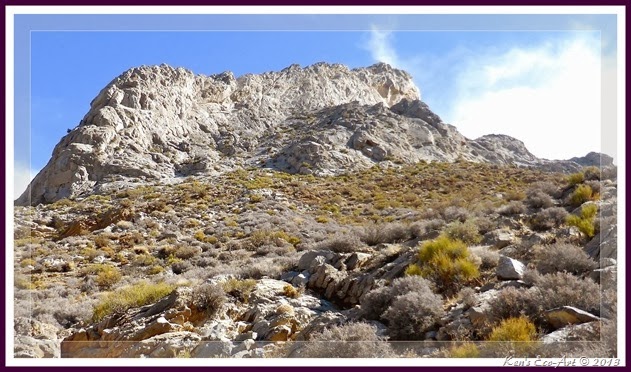 |
| (Fig. 01) |
|
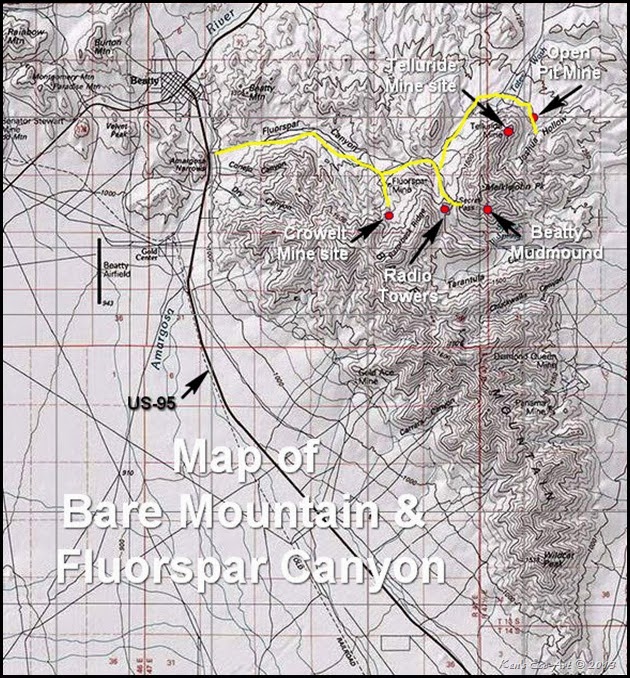 |
| (Fig. 02) |
|
Directions: From Las Vegas, follow US-95 North for approximately 115 miles to the mining town of Beatty, Nevada (Fig. 02). Just before entering the center of town, turn right (east) onto an unmarked dirt road. This unmarked dirt road runs straight into Fluorspar Canyon, around and behind the Bare Mountain.
06/19/2019 Trip Notes: On today's visit to Fluorspar Canyon I was accompanied by Jim Herring, Bob Croke and Ron Ziance. This was the first time any of them have ever been here before. We spent and couple of hours roaming the mountains checking out some of the mines. We came across more than a dozen of burros during our visit. Click here for pictures and a description of this visit ... Flurospar Canyon - 06/19/2019 Trip Notes.
|
11/18/2013 Trip Notes: Today, my friend Harvey Smith and I explored the eastern side of the Bare Mountains, just south of Beatty Nevada. Access to the area is a well graded dirt road that runs due east into Fluorspar Canyon off of US-95 in an area known as the Amargosa Narrows, just south of town. This road circles the northern end of the Bare Mountain Range, an area that is rich with mines ranging from simple hand dug adits, to deep shafts, to huge open pit excavations (Fig. 03). This entire area was known as the Fluorine District, a.k.a. Bare Mountain District. One could spend days trying to explore all that this area has to offer. As we were looking for a place to off-load the Ranger, we came upon a two small bands of Burros (Figs. 04-06). After considerable coaxing, I finally got three of them to pose for a family portrait (Fig. 07).
Our first stop of the day was at the old Crowell Mine site (see below). Looking due north from this remote, isolated, hillside, there were expansive views of Fluorspar Canyon and the southern end of Perolite Canyon (Fig. 13). From here we drove east and then south along the eastern side of Razorback Ridge to Secret Pass and the Great Beatty Mudmound (Fig. 01), a 480-million-year-old fossil site. When we set out this morning, our main goal for the day was to find and hike to the top of the Great Beatty Mudmound (see below). Unfortunately, the 4WD road fell far short of the 'mudmound', necessitating a rather steep and arduous climb just to reach the base of this limestone protrusion. Once we finally reached it we climbed around its northern end to a point on the back side that was still far below the actual summit. Though we found several small examples of shells and other sea life (Fig. 17), we saw nothing of any real size or magnitude. Discouraged by our findings so far, and without the guarantee of finding specimens anymore substantial than what we had already seen to this point, we decided to head back down. The view from the high point of our climb provided glimpses of the town of Beatty and Rhyolite far in the distance (Fig. 18). About halfway down I took a picture looking due west of the abandoned radio towers located on a hill just below Razorback Ridge (Fig. 19).
Leaving this area we backtracked about a mile to a 4WD road that led us northeast through Tates Wash (Fig. 02). We then took another 4WD road that led us around to the backside of the Meiklejohn Ridge, past a large open pit mine (Fig. 03) and down Joshua Hollow to the Telluride Mine site (see below). While hiking out on a hillside that overlooked the open pit mine on the way to the Telluride site, I felt someone looking at me. When I turned and looked up, I spotted a beautiful Bighorn Sheep (Figs. 08 & 09) starring down at me from the top of the ridge. Shortly after I turned to zoom in for a picture, he quickly retreated down the backside of the ridge. When we reached the Telluride Mine site we climbed up to three of five tailing piles that were visible on the side of the ridge. The first one we came to was a deep shaft surrounded by barbed wire (Figs. 20-22). While climbing to these mine sites, we once again spotted several Bighorn Sheep that were grazing upon the hillside (Figs. 10 & 11).
|
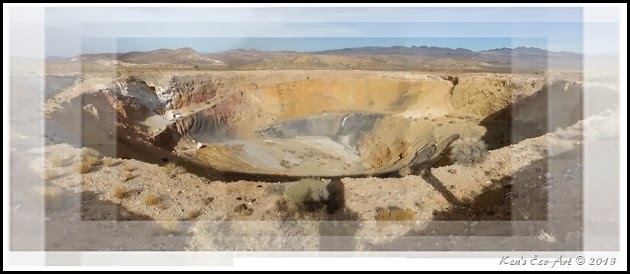 |
| (Fig. 03) |
|
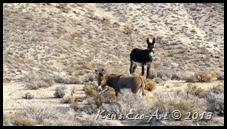 |
| (Fig. 04) |
|
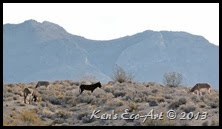 |
| (Fig. 05) |
|
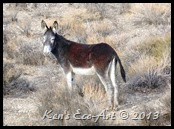 |
| (Fig. 06) |
|
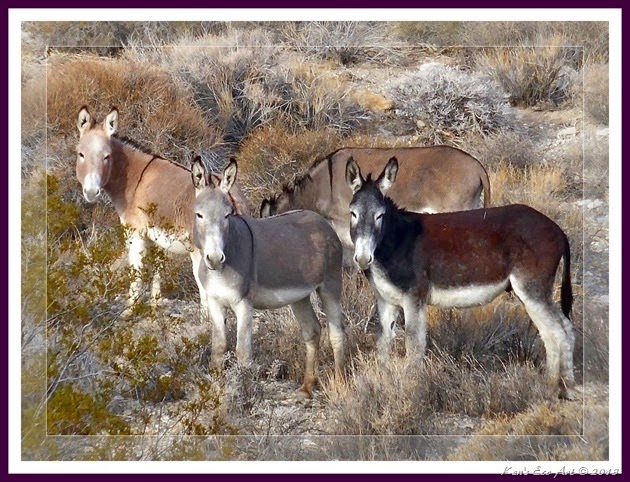 |
| (Fig. 07) |
|
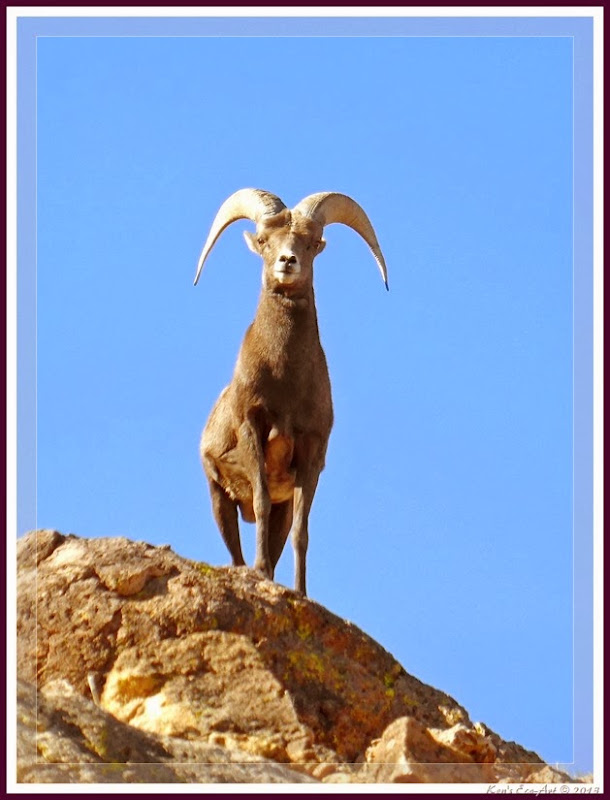 |
| (Fig. 08) |
|
 |
| (Fig. 09) |
|
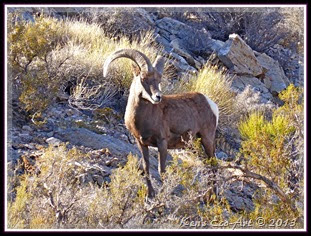 |
| (Fig. 10) |
|
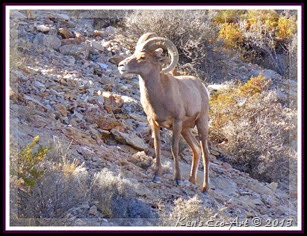 |
| (Fig. 11) |
|
|
|
Crowell Mine/Daisy Mine: The top of the knoll contained the remains of a once well built stone and wood cabin (Fig. 12). From what I have gathered, the Crowell mine was one of two owned by the Crowell family, and operated from the late 19-teens until 1989. The only mineral ever shipped from the workings was fluorspar, though small amounts of cinnabar could be found throughout the deposit; no uranium was present. Fluorspar can exist in almost any color of the rainbow, but the ore of our deposit was mostly dark purple, with small floaters of crystalline forms in white or a blue so dark it was almost black. Some samples of the ore taken from here are held by the Smithsonian. Small bits can be found in the old dumps at the site. These dumps are far smaller than the extent of the underground workings would suggest.
The site with the old stone cabin is actually the main workings; the smaller site over by the old wood buildings/ruins to the southwest is a secondary shaft that never connected with the main site. The family worked that secondary site off and on through the late 70s and early 80s, as it provided a lower-grade ore which was not suitable for the steel business but was still acceptable for use in cement-making. There is also a minor working on the backside of the first major ridge southwest of the main site; this site provided the only "acid grade" ore of the deposit, it is a beautiful golden crystalline form that is difficult to polish but worth the effort if you can find a large enough specimen. The photo in (Fig. 15) is of the main surface workings; it was taken while it was still active. Our daily production in "modern times" ran to about 24 tons per day.
The main shaft is 600 feet deep, with 13 different working levels, not all of which open to the shaft. The walls of the shaft itself are framed with dozens of 10-inch square beams. This shaft was covered with the concrete slabs due to the 'attractive nuisance' nature of the site. These old shafts pose a tremendous risk to the careless or unwary because timbers rot in the dry desert air, though that process is not always externally visible. Thus weakened, the support of the ground around the collar (shaft opening) can give way without warning. Just a few hundred feet east of this shaft there is evidence of a mine cave-in (Fig. 14).
In the late 70s and on through the 80s, several gold companies did a lot of core drilling on the Crowell claims in the canyon, and they found a lot of gold, but most of it was quite deep, 400 feet and greater below the surface. They reported finding several thousand tons of proven gold ore, but it averaged 500-600 feet deep. The geologist joked that they were there about 400 years too early! The company offered to contract the Crowell's to run a lateral over into the ore body, but it is said that they declined because there was no way to pull enough ore out through such a small shaft to make it pay off. One body of gold ore was mined by open-pit process about half a mile west of the mine, in the base of the south side of the canyon, you can see the pit clearly.
The primary mine in the area, called The Daisy Mine, a.k.a. Daisy Fluorspar
(1) Mine, is located in the hills just northwest of this site, and was a producer of Fluorine-Fluorite. Both mines were a private claim once owned by J. Irving Crowell, Jr. and son. The Daisy Mine was discovered in 1918 and produced continuously from 1927 through the early 1960s. Total production up to that date was approximately 100,000 tons. Considerably more has probably been mined sine then, one ought to presume, as the Daisy Flourspar Mine is likely one of the single greatest sources of fluorspar in the history of Nevada. The ore bodies occur as hydrothermal replacements in dolomites of the Upper Cambrian (515 million years old) Nopah Formation; cinnabar--mercury sulfide--has also been reported from the Daisy Mine, primarily as thin red stringers between fluorite and bands of calcite.
NOTE: Much of the information provided above, as well as the photo in (Fig. 15), was provided to me in an email from Jeff Crowell, son of the owner, who spent three summers working the mines between 1974 and 1977.
(1) Fluorspar, of course, is simply the commercial term used for fluorite, the mineral form of calcium fluoride, which is the primary source of the element fluorine and fluorine compounds. Mineralogically speaking, fluorite has a Mohs hardness of 4.0, a specific gravity of 3.01 to 3.25 and a vitreous luster. It is usually found in shades of white, yellow, rose and crimson-red, violet blue, sky blue, brown, wine yellow, greenish blue and violet blue. And, naturally, fluorspar has numerous important commercial applications. For example, the manufacture of steel requires, on the average, from three to 12 pounds of fluorite for every ton of the finished product. It was also used to manufacture the fluorocarbon compounds that found their way into refrigerants, aerosols, solvents and plastics. As an important additive to glass, ceramics and enamel, fluorite improves the strength of these products in addition to imparting a greater luster and transparency. And in the aluminum industry, a healthy 150 pounds of fluorite are required to produce a single ton of the metallic aluminum from the raw ore bauxite.
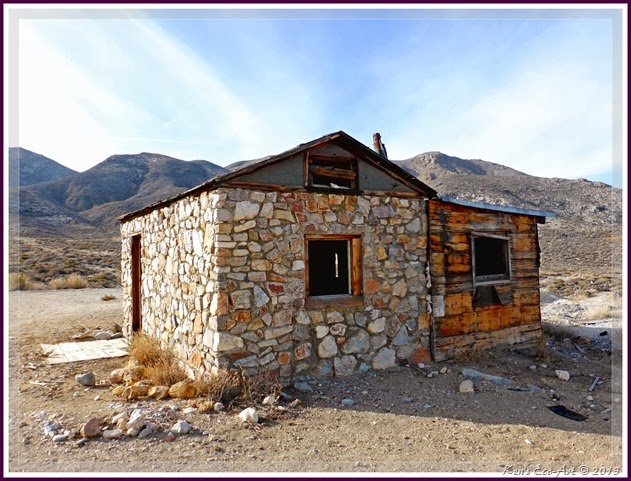 |
| (Fig. 12) |
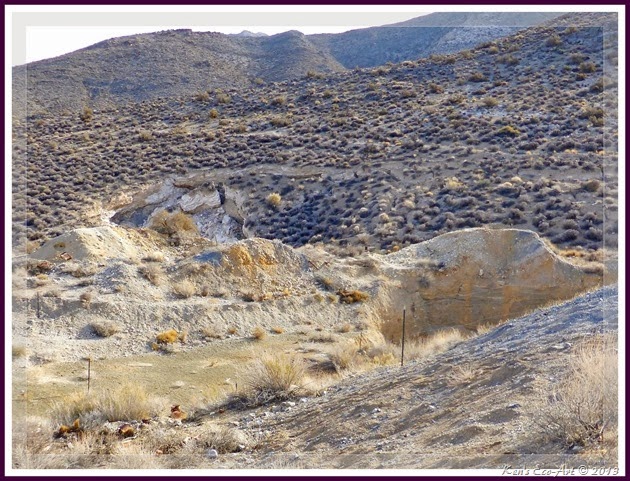 |
| (Fig. 13) |
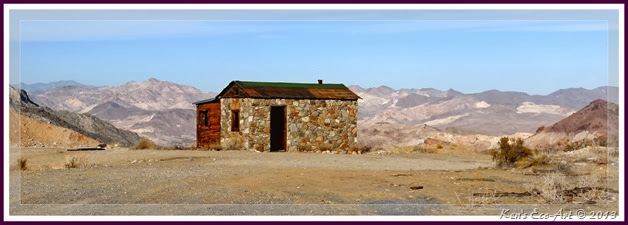 |
| (Fig. 14) |
 |
| (Fig. 15) |
|
The Great Beatty Mudmound: This bioherm was first recognized in 1960 by geologists H.R. Cornwell and F.G. Kleinhampl during their geological mapping of the region. When we set out this morning, our main goal for the day was to find and hike to the Great Beatty Mudmound (Fig. 16). This pod-shaped accumulation of calcium carbonate is some 270 feet thick and more than 1,000 feet in length as it protrudes from the west side of a mountain above Secret Pass just south of Meiklejohn Peak, elevation 5,940 feet. To gain a better appreciation of the mudmound's dimensions, one must hike up a steep canyon wash and stand near the base of it. From this up-close-and-personal vantage point, this uncommon geological structure is a massive, pale gray body of limestone exposed along the skyline of the mountains, that truly dominates the view. It was much bigger than we expected. Written reports on the Internet indicate that the core of this formation contains a wealth of excellently preserved invertebrate animal remains some 480 million years old, including echinoderms, sponges, bryozoans, ostracodes (tiny bivalve crustaceans related to barnacles), pelecypods, gastropods, trilobites, conodonts, cephalopods and brachiopods. The specimens are restricted to sporadic, productive pockets within the core of the mudmound and to, more abundantly, the medium gray to olive-gray and olive-brown shaley limestones along its flanks and directly above the mudmound itself. other calcium carbonate layers contain prolific quantities of brachiopods, most of which are rather tiny.
|
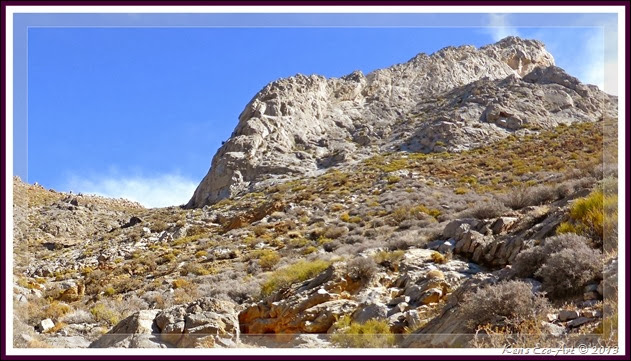 |
| (Fig. 16) |
|
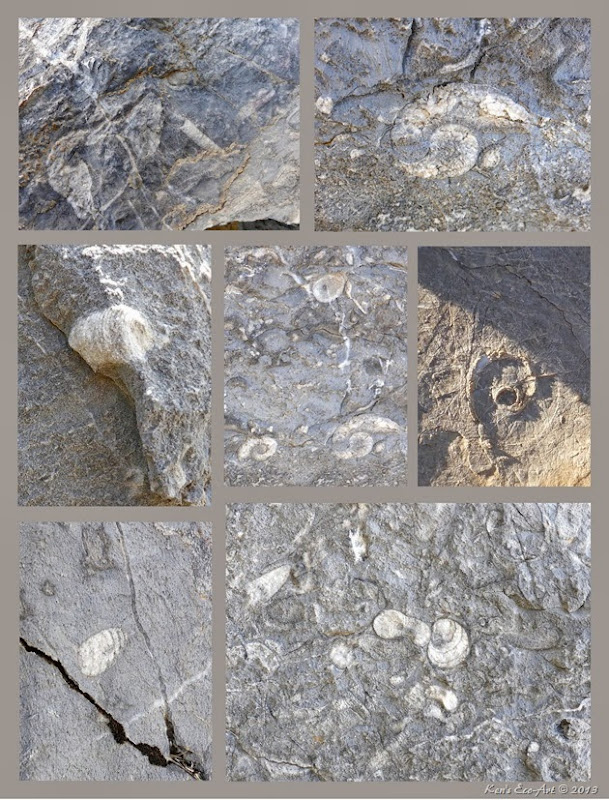 |
| (Fig. 17) |
|
 |
| (Fig. 18) |
|
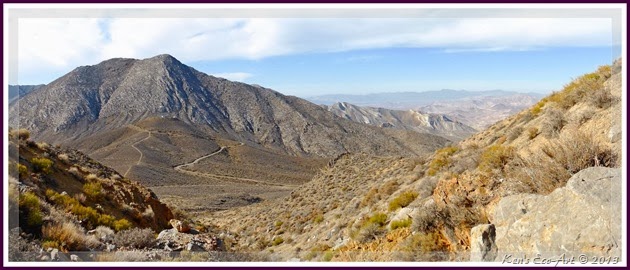 |
| (Fig. 19) |
|
Telluride Mine: This general area was called the Telluride Mine District. The Telluride Mine was largest claim here and consisted of no less than five diggings. Significant trace concentrations of the elements antimony, arsenic, cadmium, copper, gold, lead, molybdenum, silver and zinc have been reported here. The old Telluride Mine itself -- for which the district was named -- is curiously enough an old mercury deposit, discovered in 1908. Up to 1943 production from the mine had amounted to 72 flasks of mercury. It was active once again in 1956, but there is no available report of the total take. The mercury occurs as cinnabar sparsely disseminated through opal and chalcedony of a steeply dipping bed of dolomite in the Devonian (408 to 369 million years ago) Fluorspar Canyon Formation. Another working, the Tip-Top Mine located 600 feet north of the Telluride deposit, reportedly yielded 100 flasks of mercury up to 1944.
|
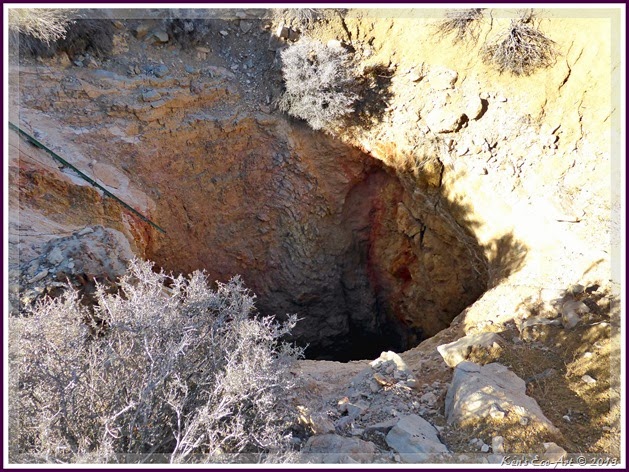 |
| (Fig. 20) |
|
 |
| (Fig. 21) |
|
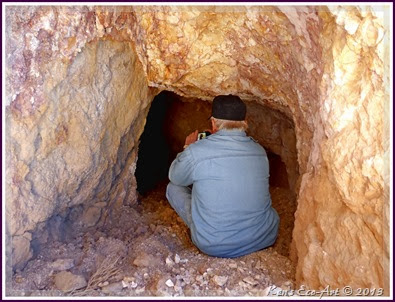 |
| (Fig. 22) |
|
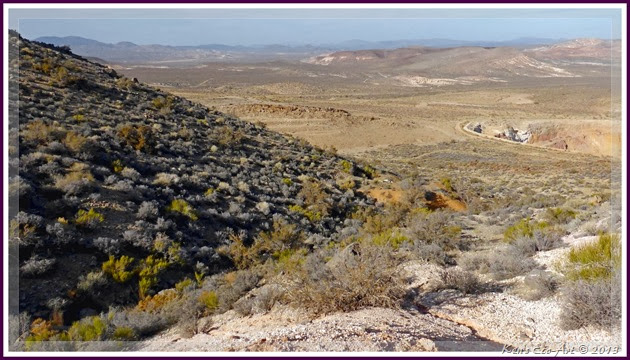 |
| (Fig. 23) |
|























